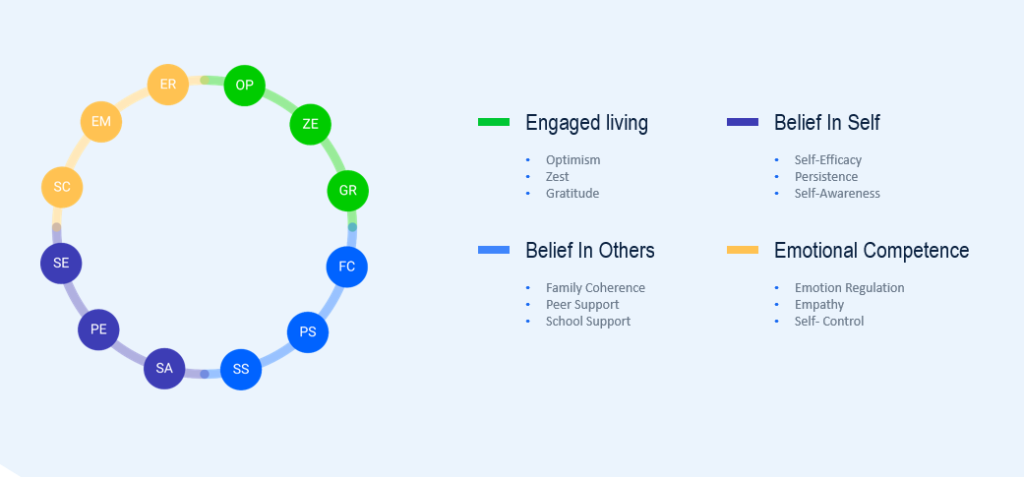The CoVitality framework features the social emotional health surveys (SEHS), developed at the University of California Santa Barbara and funded by the Federal Institute of Educational Sciences.
At a glance:
| Grade Levels | SEHS-S = 4th, 5th SEHS-P = 6th-12th |
| Available Languages | English, Spanish |
| Respondent Format | Student self-report |
| Method of Administration | Digital |
| Number of Items | 36 |
| Administration Time | 15 to 25 Minutes |
How was the tool developed?
Funded by federal grants from the Institute of Education Sciences and published in over 35 peer reviewed journals, the CoVitality Social Emotional Health Survey uses the world’s best social science research to assess the mental health and overall well-being of all students.
The screener measures 12 personal strengths or assets across 4 domains that have been shown to be the most important factors in a child’s social and emotional well being.

What type of screener is CoVitality?
A self-report survey questionnaire.
Students rate their own abilities on an ordinal rating scale. Especially useful assessment format for collecting information about student awareness (i.e., beliefs or thought processes such as feeling empathy and social awareness), which is not easily assessed using other methods that rely on external observers.
The measure includes sufficient items to assess and report scores for individual domains of SEL competence, in addition to an overall SEL competence score.
What does it measure?
The SEHS-S measures 12 individual strengths which are known indicators of psychological well-being (optimism, zest, gratitude, emotional regulation, self control, empathy, family support, peer support, school support, self-awareness, self-efficacy, persistence) grouped under 4 core domains (Engaged Living, Emotional Competence, Belief in Others and Belief in Self).

In addition, a scale for life Satisfaction and a psychological distress measure complete the dual-factor model to measure holistic wellness of students.
The SEHS-P (Furlong et al., 2013) is a 20-item self-report measure of covitality for primary school children. Covitality in the SEHS-P is measured from 16 items, with 4 items each assessing gratitude, optimism, zest and persistence.
What is the geographic adoption of the framework?
The CoVitality screener has been administered across the world in 15 countries, on 5 continents, and is currently being used across 14 states in the US. With this widespread administration has come translations of the screener into multiple languages and very reliable norms across cultures, ethnicities, and languages.
Have a resource you want to share with our national community of CoVitality champions? Taking the charge with SEL and student wellness support in your school or district? Or, just want to get in touch to chat about our shared passion to support the next generation’s flourishing wellbeing?
We’d love to connect! Send us a message directly at info@covitality.com, or follow us on Twitter, Instagram, LinkedIn, and Facebook to stay in the know with all of the latest CoVitality community updates.
